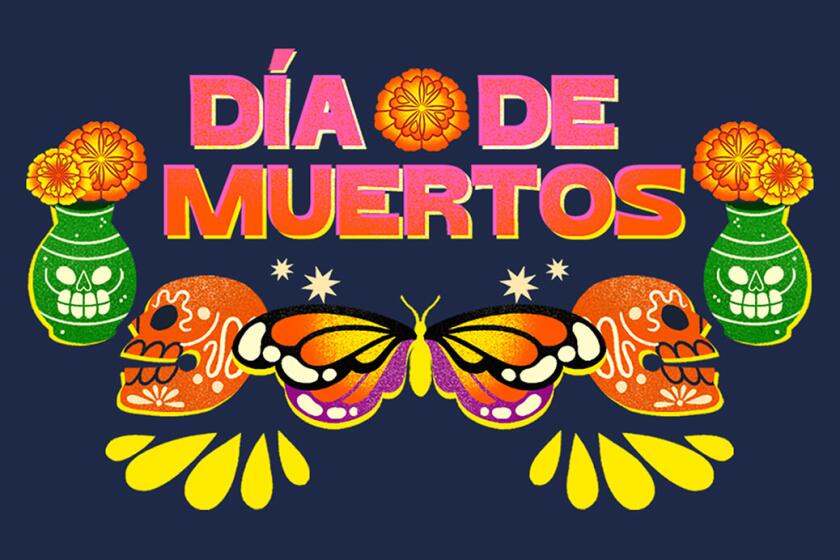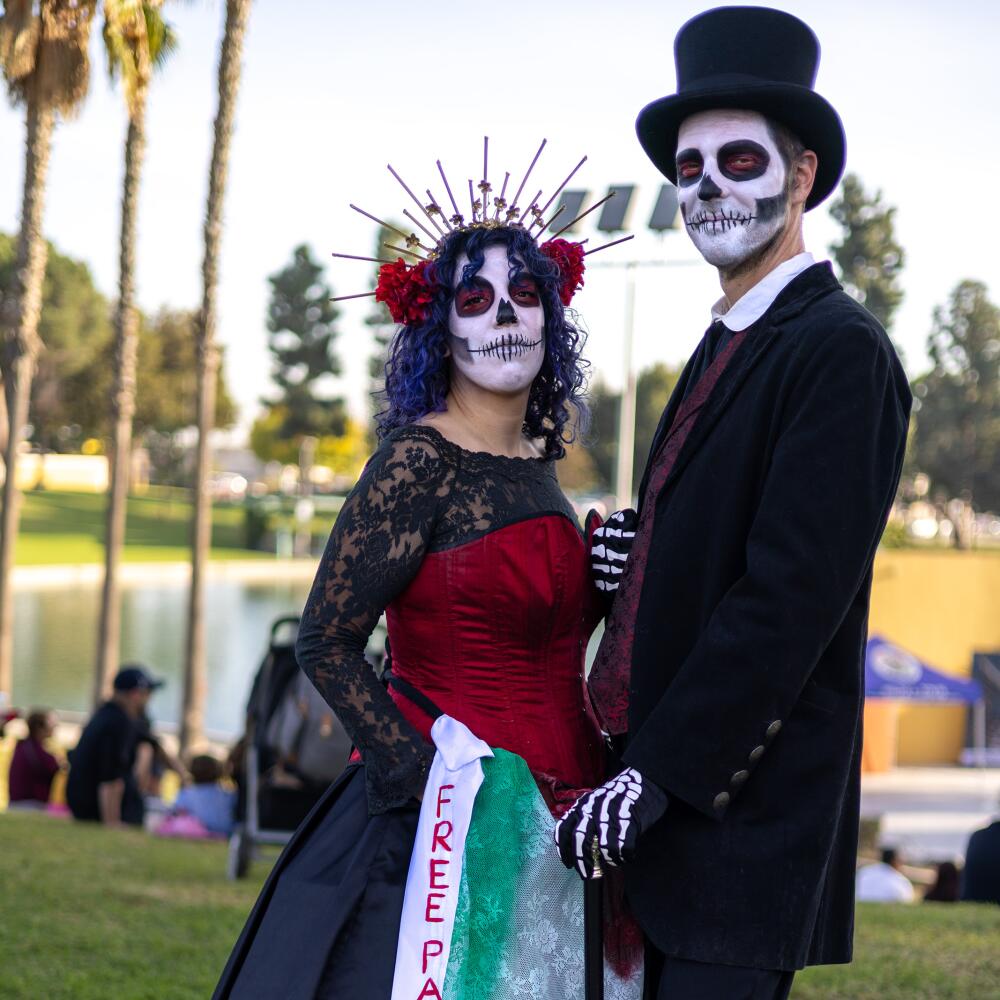
- Share via
Death is the great equalizer. At Self Help Graphics, an organization where art and social justice intersect, Día de los Muertos is an opportunity to share that message to the living world in hopes that equality can be achieved before death.
Self Help Graphics’ Day of the Dead Celebration begins in Boyle Heights’ Mariachi Plaza. Despite ongoing renovations to Self Help’s First Street corridor building, the annual tradition took off at high speed with the first-known procession via L.A. Metro.
The flickering strum of a wheeled double bass set the tone inside the Metro car. Accompanied by guitar and accordion, Tex-Mex band Carlos y Charlos covered corridos and rancheras such as “Cruz de Madera,” a song popularized by Ramón Ayala that implores loved ones to not stress over the luxury items of death.
“I don’t want a coffin that is worth millions, I only want you to sing songs,” the band sang in Spanish amid the crowd of painted faces.
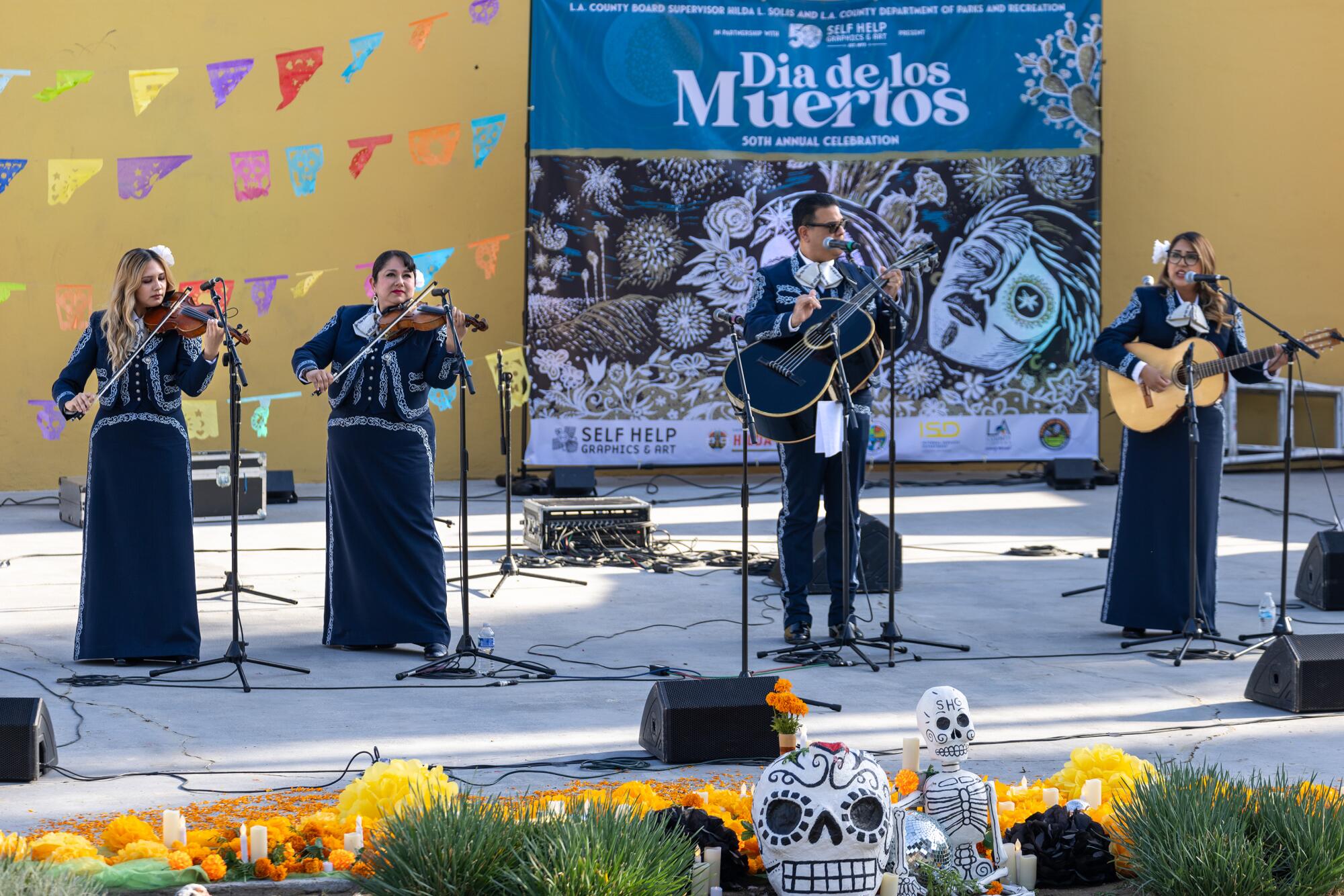
The procession that began at Mariachi Plaza station came to a close as the train arrived at the East L.A. Civic Center. The end of the journey also marked the official start of Self Help Graphics’ 50th Día de los Muertos celebration.
In partnership with the Los Angeles County Office of Supervisor Hilda Solis and the Los Angeles County Department of Parks and Recreation, the annual tradition livened Belvedere Park Lake with performances, a marketplace, altars, face painting, food vendors and a resource fair.
The long-standing celebration began in 1973 with Sister Karen Boccalero, founder and former director of Self Help Graphics.
The tradition of venerating loved ones with an ofrenda, or altar, decorated with cempasúchil (marigold) flowers, their favorite meals and their image originates from Indigenous cultures in Latin America. The belief is that life extends beyond death, and items placed on the ofrenda help guide late loved ones to the living world.

Self Help Graphics executive director Jennifer Cuevas recognized the nature of the event as one that has been transformed over time.
“Dia de los Muertos is very uniquely a pre-Columbian kind of holiday that we’ve adopted. It is something that is shared across generations and across many different cultures,” Cuevas said.
When the Self Help event began 50 years ago, there was little understanding of the now heavily commercialized celebration, according to legacy artist consultant Consuelo Flores, who started building altars for the event in 1989.
Flores would ask her mother-in-law to bring her books from Mexico on Día de Muertos in order to ensure authenticity in her altar-making.

“I’d never done an altar before … and there were no books here in Los Angeles on the celebration,” Flores said.
For Flores, this event signifies a collective grief.
“[Día de Muertos] allows people to not only process their grief by creating these beautiful celebrations of life and remembrances but also to do it in a collective manner,” Flores said.
Though traditionally it is the living who guide the dead during this time, it is the dead who guide the living at the Self Help Graphics’ Día de Muertos event.
Día de Muertos is a time to celebrate and honor the dead. From ofrendas to James Bond, De Los explored the origins and evolution of the holiday.
Papel picado representing the Palestinian flag hung across an archway of an altar and below it a traditional Palestinian keffiyeh scarf. Pictures of Palestinian children were placed throughout the altar, including an image of 6-year-old Wadea Al-Fayoume, who was murdered in Illinois in October.
Alongside collages of Palestinian children were portraits of Indigenous female activists, including murdered Honduran activist Berta Cáceres, and a book titled “Feminism and War: Confronting U.S. Imperialism.”
Flores says that the idea of using an altar as both an act of remembrance and justice is part of what the Chicano community has embraced in Los Angeles. She credits the legacy of Mexican political lithographer José Guadalupe Posada, who considered death “the great equalizer.”
“In Mexico, there’s a saying that everyone is alike in the grave. You don’t have distinctions, you don’t have borders, you don’t have prejudices,” Flores said.
Down the sidewalk was an altar dedicated to Anthony Daniel Vargas, a 21-year-old who was shot 13 times by Los Angeles County sheriffs in East L.A. His altar overlooked the lake he would frequent as an avid fisherman. The signage asked onlookers to “Google LASD Gangs.”
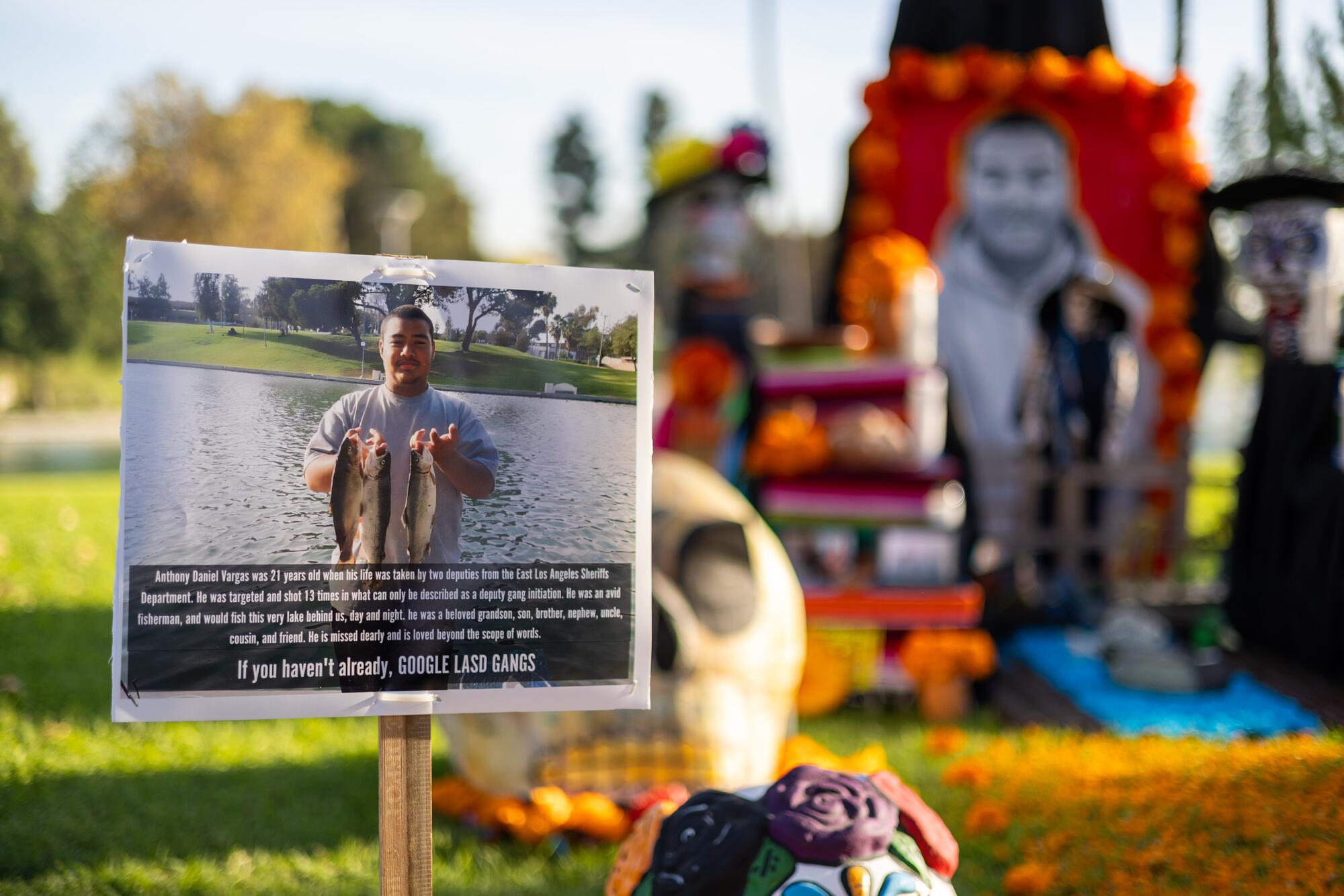
On the other side of the park was an altar honoring two Oaxacan victims of the Half Moon Bay shooting earlier this year, Marciano Martínez Jiménez and José Romero Pérez.
Across the way was an altar dedicated to teachers, which centered on Uvalde Elementary School shooting victims Eva Mireles and Irma Garcia.
Natalie Cruz was especially moved by the altar dedicated to Vanessa Guillén, which was organized by the East Los Angeles Women’s Center.
“She was so young. … She was just trying to seek a better future for her family,” Cruz said.
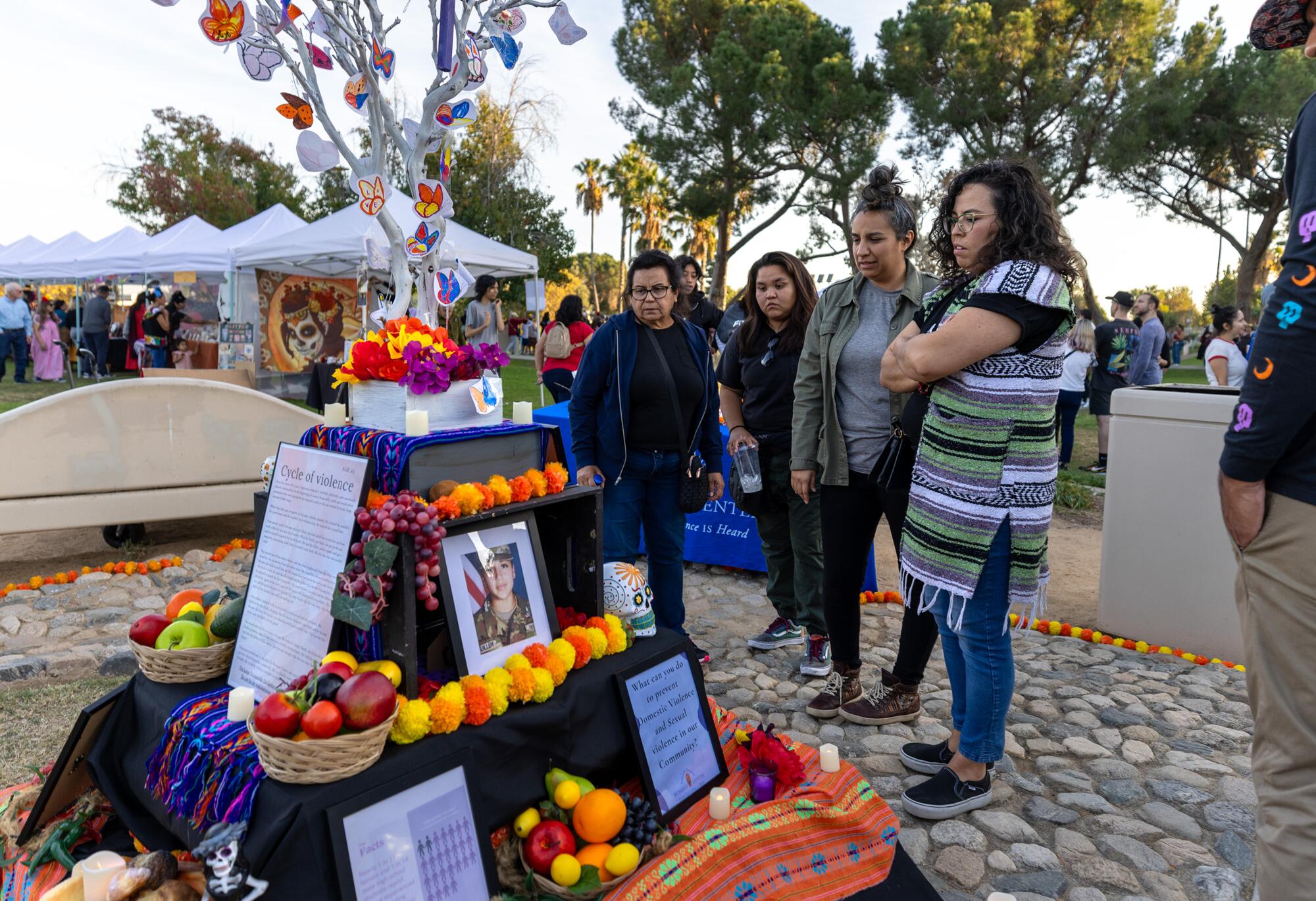
Guillén was murdered in 2020 by another soldier, which sparked a movement about sexual abuse in the military and changes in how it is reported.
“A lot of us first-generations have been driven to get into military service just so that we can help our parents who are undocumented,” Cruz said.
For 50 years, Self Help Graphics has transformed Día de Muertos into an event that extends beyond the celebration of life and death.
“Day of the Dead has become a way of reminding people that social justice is necessary to live life the way we die, which is equal,” Flores said.
More to Read
The Latinx experience chronicled
Get the Latinx Files newsletter for stories that capture the multitudes within our communities.
You may occasionally receive promotional content from the Los Angeles Times.

